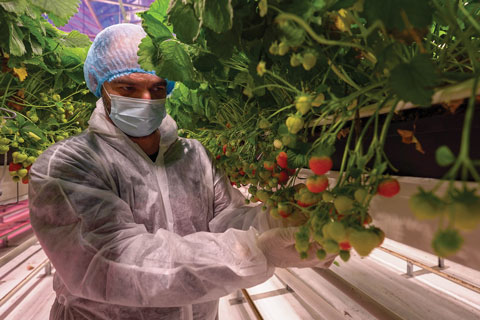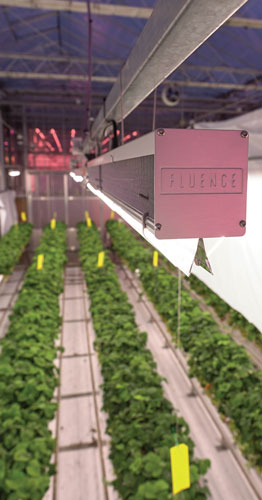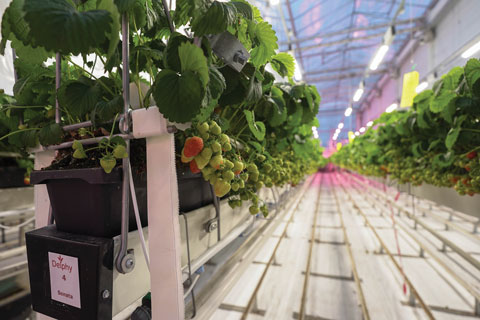5/1/2022
Maximizing Strawberry Production
Dr. David Hawley

Few things can unite people more than a love of strawberries.
OK, that may be a slight exaggeration, but strawberries have a long history full of lore across cultures and geographies. Strawberries are the focus of a Cherokee Nation creation myth symbolizing kindness and friendship. The ancient Romans believed strawberries treated melancholy, bad breath, kidney stones, inflammation, infections and other maladies. Medieval stone masons carved strawberries on cathedrals and churches to symbolize righteousness. In the 16th century, English writer Dr. William Butler claimed of strawberries, “Doubtless God could have made a better berry, but doubtless God never did.”
Today, Belgium has an entire museum—the Musée de la Fraise et Promotion du Pays de Wepion—dedicated to the strawberry. It’s the signature snack at Wimbledon, where attendees consume more than 55,000 pounds of strawberries every year.
 Modern consumers are starting to learn what many throughout history have known about strawberries: they’re delicious. A January 2021 report from the United Nations Food and Agriculture Organization found that global strawberry production has increased by 39% in the last decade to meet growing demand. The September 2021 “Tree & Nuts Outlook” from the U.S. Department of Agriculture noted a 16% increase in domestic strawberry production from 2018 to 2020 compared to 2008 to 2010.
Modern consumers are starting to learn what many throughout history have known about strawberries: they’re delicious. A January 2021 report from the United Nations Food and Agriculture Organization found that global strawberry production has increased by 39% in the last decade to meet growing demand. The September 2021 “Tree & Nuts Outlook” from the U.S. Department of Agriculture noted a 16% increase in domestic strawberry production from 2018 to 2020 compared to 2008 to 2010.
Rising demand for strawberries has driven a commensurate increase in supply—especially in summer months most conducive to production. For many cultivators in the U.S. and around the world, achieving year-round crop consistency remains one of the pre-eminent challenges. Consistent demand in winter months means that cultivators can’t afford any gaps in production, while consumer purchasing behavior means that cultivators also must place renewed focus on fruit quality.
In Europe especially, the need to achieve both of those goals is driving strawberry production into greenhouses and vertical farms, where controlled environments allow cultivators to capitalize on the benefits of supplemental lighting, better manage disease occurrence, and ultimately, tap into strawberries’ enhanced winter market value.
 Indoor strawberry production is still very much an emerging market. Cultivators and their partners are exploring general cultivation methodologies, assessing optimal plant density, grappling with multiple flushes versus multiple plantings, and tinkering with genetics. We won’t solve every challenge overnight—cultivation dynamics unique to each operation and geography see to that. Nevertheless, early results on the ground and a growing body of research into indoor strawberry production indicate enormous potential for cultivators to capitalize on emerging opportunities by delivering more high-quality fruit more consistently.
Indoor strawberry production is still very much an emerging market. Cultivators and their partners are exploring general cultivation methodologies, assessing optimal plant density, grappling with multiple flushes versus multiple plantings, and tinkering with genetics. We won’t solve every challenge overnight—cultivation dynamics unique to each operation and geography see to that. Nevertheless, early results on the ground and a growing body of research into indoor strawberry production indicate enormous potential for cultivators to capitalize on emerging opportunities by delivering more high-quality fruit more consistently.
The crucial factor in realizing that potential is, of course, light.
Selecting the right cultivars
The viability of June-bearing versus everbearing strawberries remains a major point of contention for cultivators, but it’s important to consider how cultivation dynamics change in indoor environments. In field production, June-bearing strawberries will produce one large harvest in the spring and summer months, while everbearing strawberries will typically yield three harvests from spring to fall.
In controlled environments that leverage supplemental lighting, however, June-bearing strawberries can yield multiple harvests per year using multiple flushes or by replanting after first harvest. June-bearing strawberries are generally more reliable and produce higher-quality fruits, while everbearing features steadier production, but greater variances in quality.
As with most aspects of production, there’s no universally correct answer, and it’s important that cultivators work with their partners to determine which cultivars and varieties are better-suited to meet their specific production goals.
As part of Fluence’s inaugural flagship research of indoor strawberry production, we selected June-bearing strawberries to study three key cultivation parameters: morphology, yield and quality.
Supplemental LED lighting’s impact
At the end of 2020, Fluence partnered with Delphy Improvement Centre, a state-of-the-art greenhouse complex in the Netherlands, and the prestigious Wageningen University & Research to study supplemental lighting’s impact on two June-bearing strawberry cultivars: Sonata and Sonsation.
The triple-replicate study analyzed production under four light spectra at a photosynthetic flux density of 200 μmols/m2/s—white light, white light with a fraction of far-red, pink light and pink light with a fraction of far-red—with winter and spring flushes.
The study found that both cultivars grown under a broad spectrum with a fraction of far-red light saw taller crops, wider canopies, higher overall yields and increased Brix values.
Morphology
One of the study’s key findings was far-red light’s positive impact on crop morphology. Sonata and Sonsation cultivars saw 68% and 40% taller crops, as well as 28% and 29% wider canopies, respectively, under a white spectrum with a fraction of far-red in relation to a pink spectrum.
While morphology is a critical parameter for all plants, strawberry crops in particular benefit from enhanced height and wider canopies. Beyond the obvious benefits of improved light interception, strawberries are highly susceptible to diseases like Botrytis that thrive in compact, humid environments. Improved morphology in height and width reduce pathogenic pressure, provide better airflow through and around the canopy and increase transpiration—not to mention making it easier for harvesting.
Yield
Researchers also recorded significant increases in yields—with and without fruit waste, which can be processed into jams, jellies and preserves to extend commercial value—of both cultivars under a white spectrum with a fraction of far-red. Compared to the pink-only treatment, Sonata saw a yield increase of 13% under white light with far-red, excluding waste and an 11% increase with waste included. Similarly, Sonsation yields increased by 18% without waste and 14% with waste.
Results were consistent with researchers’ hypotheses, but nevertheless confirm the crucial benefits and viability of a spectral strategy that combines white light with far-red to improve and optimize June-bearing strawberry cultivation.
Quality
We’ve known for some time that consumer purchasing behavior of strawberries is dominated by perceived smell. A 2015 German study found that 92% of consumers preferred strawberries “with intense or fruity aroma,” followed by sweet taste (66%), juiciness (58%) and color uniformity (43%). Yet fruit quality can often come at the expense of other metrics, like total yield, especially at commercial scales. For an emerging strawberry market, that creates lucrative opportunities and competitive advantages for cultivators who can produce the highest-quality fruits without sacrificing yields.
 Fortunately, the results of Fluence’s study indicate that it’s possible for cultivators to achieve both under the right spectral strategy. Researchers noted 14% higher Brix values in Sonata fruit under white light with far-red compared to pink and 6% higher Brix values in Sonsation.
Fortunately, the results of Fluence’s study indicate that it’s possible for cultivators to achieve both under the right spectral strategy. Researchers noted 14% higher Brix values in Sonata fruit under white light with far-red compared to pink and 6% higher Brix values in Sonsation.
Researchers also conducted a sensory panel assessing 18 different attributes—including firmness, various aromas, flavor, sweetness and others—and a chemical analysis of a range of compounds. Results showed that, in Sonata, far-red positively affected flavor levels and aroma favorability. In Sonsation, far-red increased juiciness and aroma presence.
While qualitative characteristics that influence consumer purchasing behavior are, of course, always up for interpretation—and while spectral sensitivity is ultimately cultivar-dependent—results of this study definitively show the impact light spectra have on overall quality.
We can also make smart inferences about research applications for other cultivars. In everbearing strawberries, for instance, we anticipate that growers will see similar results particularly across canopy morphology and yield. It also lays the foundation for even more research into light’s impact on different elements of strawberry production, a journey of discovery that Fluence and our partners can’t wait to share to drive the emerging strawberry market into the future. IG
Dr. David Hawley leads the scientific research initiative at Fluence as the company's principal scientist. His experience in controlled environment systems, horticultural lighting and cannabis metabolome naturally underpins Fluence’s mission to drive industry-leading lighting research to explore the interaction between light and life. Find out more at https://fluence.science.